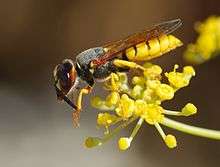European beewolf
| European beewolf | |
|---|---|
 | |
| A European beewolf | |
 | |
| European beewolf paralyzing a bee | |
| Scientific classification | |
| Kingdom: | Animalia |
| Phylum: | Arthropoda |
| Class: | Insecta |
| Order: | Hymenoptera |
| Family: | Crabronidae |
| Subfamily: | Philanthinae |
| Genus: | Philanthus |
| Species: | P. triangulum |
| Binomial name | |
| Philanthus triangulum (Fabricius, 1775) | |
| Synonyms | |
| |
Philanthus triangulum, commonly known as the European beewolf or the bee-eating philanthus (from the now obsolete synonym Philanthus apivorus), is a solitary wasp that lives in Europe and Northern Africa. Although the adults of the species are herbivores (feeding on nectar and pollen), the species derives its name from the behavior of the inseminated females, who hunt Western honey bees. The female places several of its paralyzed prey together with an egg in a small underground chamber, to serve as food for the wasp larvae. All members of the genus Philanthus hunt various species of bees, but P. triangulum is apparently the only one that specializes in Western honey bees.
Status in the UK
This wasp was previously considered to be one of the great aculeate rarities in Britain, with colonies only in sandy habitats on the Isle of Wight and Suffolk. It has undergone an expansion in range, with the wasp now locally common in a steadily increasing number of sites as far north as Yorkshire (2002). The species has RDB2 status (vulnerable) but, if revised, it is now likely that this status will be removed because of its increase in range and population.[1]
References
- ↑ "Species Account for Philanthus triangulum". Essex Field Club. Retrieved 28 August 2013.
External links
| Wikimedia Commons has media related to Philanthus triangulum. |